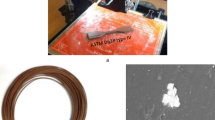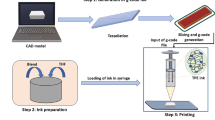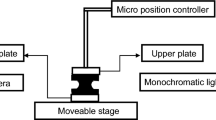Abstract
A mathematical modeling approach was proposed combining the capabilities of response surface methodology (RSM) and desirability function (DF) and implemented successfully in production of printing toner particles. Toner powders were systematically synthesized through suspension copolymerization process. Applying RSM, a series of experiments were designed and toner particles were prepared and the effects of monomer ratio, colorant and surfactant content on the particle size (PS), particle size distribution (PSD), thermal and colorimetric properties (∆E) of the resulting toner were monitored and discussed. The second-order models corresponding to each target characteristic, i.e., PS, PSD, and ∆E of different types of toner powders, were obtained by individual optimization to express variation of each property in terms of polymerization parameters. Applying statistical calculations, the best reduced models were identified to be fed in the second step of optimization. Since toners with appropriate PS, PSD, and CP were needed, we applied multi-objective optimization based on DF approach. The results show that exact tuning of toner properties is closely possible with the aid of hybrid mathematical model developed in this work. Noticeably, desirabilities are very close to 100 %.
Graphical Abstract










Similar content being viewed by others
References
H. Kipphan, Handbook of Print Media: Technologies and Production Method (Springer, Berlin, 2001)
R.H. Leach, Printing ink Manual (Springer, Berlin, 2007)
G. Marshall, Recent Progress in Toner Technology (Society for Imaging Science and Technology, Springfield, 1997)
N. Ohta, M. Rosen, Color Desktop Printer Technology (Taylor & Francis Group, New York, 2006)
F. Andami, M. Ataeefard, F. Najafi, M.R. Saeb, from suspension to emulsion and mini-emulsion polymerisation: controlling particle size, particle size distribution, and roundness of printing toner. J. Pigment Resin Technol. 45(6) (2016, in press)
Z. Bazrafshan, M. Ataeefard, F. Nourmohammadian, Physicochemical colorants effects on polymeric composites printing toner. J. Pigment Resin Technol. 43(5), 245–250 (2013)
M. Ataeefard, Production of black toner through emulsion aggregation of magnetite, carbon black, and styrene-acrylic co-polymer: investigation on the effect of variation in components. J. Compos. Mater. 49, 1553–1561 (2015)
M. Ataeefard, F. Nourmohammadian, Producing fluorescent digital printing ink: investigating the effect of type and amount of coumarin derivative dyes on the quality of ink. J. Lumin. 167, 254–260 (2015)
M. Ataeefard, A. M. Arabi, Coloring of tiles with laser printer toner: toner designing based on ZrSiO4: Pr pigment 1st International Conference on Tile, Ceramic and Sanitary Ware, Tehran, Iran, 29–30 Nov. 2014
Z. Bazrafshan, M. Ataeefard, F. Nourmohammadian, Modeling the effect of pigments and processing parameters in polymeric composite for printing ink application using the response surface. Prog. Org. Coat. 58, 68–73 (2015)
M. Ataeefard, M.R. Saeb, A multiple process optimization strategy for manufacturing environmentally friendly printing toners. J Clean Prod 108, 121–130 (2015)
A.S. Pakdel, M.R. Behbahani, M.R. Saeb, H.A. Khonakdar, H. Abedini, M. Moghri, Evolution of vinyl chloride conversion below critical micelle concentration: a response surface analysis. J Vinyl. Addi. Technol. 21, 157–165 (2015)
M.R. Saeb, M. Moghri, H.A. Khonakdar, U. Wagenknecht, G. Heinrich, Fusion level optimization of rigid PVC nanocompounds by using response surface methodology. J. Vinyl. Addi. Technol. 19, 168–176 (2013)
D.C. Montgomery, Design and Analysis of Experiments (Wiley, New York, 2005)
M. Somasundaram, R. Saravanathamizhan, C. Ahmed Basha, V. Nandakumar, S. Nathira Begumd, T. Kannadasan, Recovery of copper from scrap printed circuit board: modelling and optimization using response surface methodology. Powder Technol. 266, 1–6 (2014)
N.R. Costa, J. Lourenço, Z.L. Pereira, Chemometr. Intell. Lab. Syst. 107, 234–244 (2011)
I.J. Jeong, K.J. Kim, Eur. J. Oper. Res. 195, 412–426 (2009)
M. Ghaedia, S. Hajatib, M. Zareea, Y. Shajaripoura, A. Asfarama, M.K. Purkait, Removal of methyl orange by multiwall carbon nanotube accelerated by ultrasound devise: optimized experimental design. Adv. Powder. Technol. 26(4), 1087–1093 (2015)
F. Andami, M. Ataeefard, F. Najafi, M.R. Saeb, Fabrication of black printing toner through in situ polymerization: an effective way to increase conversion. Prog. Color Color. Coat. 8, 115–121 (2015)
P. Ding, A.W. Pacek, K. Abinhava, S. Pickard, M.R. Edwards, A.W. Nienow, A process for the manufacture of chemically produced toner (CPT). II. Effect of operating conditions. J Ind. Eng. Chem. Res. 44(16), 6004–6021 (2005)
M. Fairchild, Color Appearance Models, 2nd edn. (Wiley, New York, 2005)
R.H. Myers, D.C. Montgomery, M. Ch, Anderson-Coo (Wiley, New York, 2011)
S. Kiatkamjornwong, P. Pomsanam, Synthesis and characterization of styrenic-based polymerized toner and it’s composite for electrophotographic printing. J. Appl. Polym. Sci. 89, 238–248 (2002)
H. Liu, S. Wen, J. Wang, J. Zhu, Preparation and characterization of carbon black-polystyrene composite particles by high-speed homogenization assisted suspension polymerization. Appl. Polym. Sci. 123, 3255–3260 (2011)
J. Yang, T. Wang, H. He, F. Wei, Y. Jin, Particle size distribution and morphology of in situ suspension polymerized toner. Ind. Eng. Chem. Res. 42, 5568–5575 (2003)
G. Galliford, Chemically Prepared Toners—A Study of Markets and Technologies (Galliford Consulting and Marketing, Ventura, 2006)
N. W. Goon, Synthesis of chemically produced toner (CPT) by emulsion aggregation process, Master Thesis, University of Malaya, 2010
Author information
Authors and Affiliations
Corresponding authors
Electronic supplementary material
Below is the link to the electronic supplementary material.
Rights and permissions
About this article
Cite this article
Ataeefard, M., Shadman, A., Saeb, M.R. et al. A hybrid mathematical model for controlling particle size, particle size distribution, and color properties of toner particles. Appl. Phys. A 122, 726 (2016). https://doi.org/10.1007/s00339-016-0242-1
Received:
Accepted:
Published:
DOI: https://doi.org/10.1007/s00339-016-0242-1




